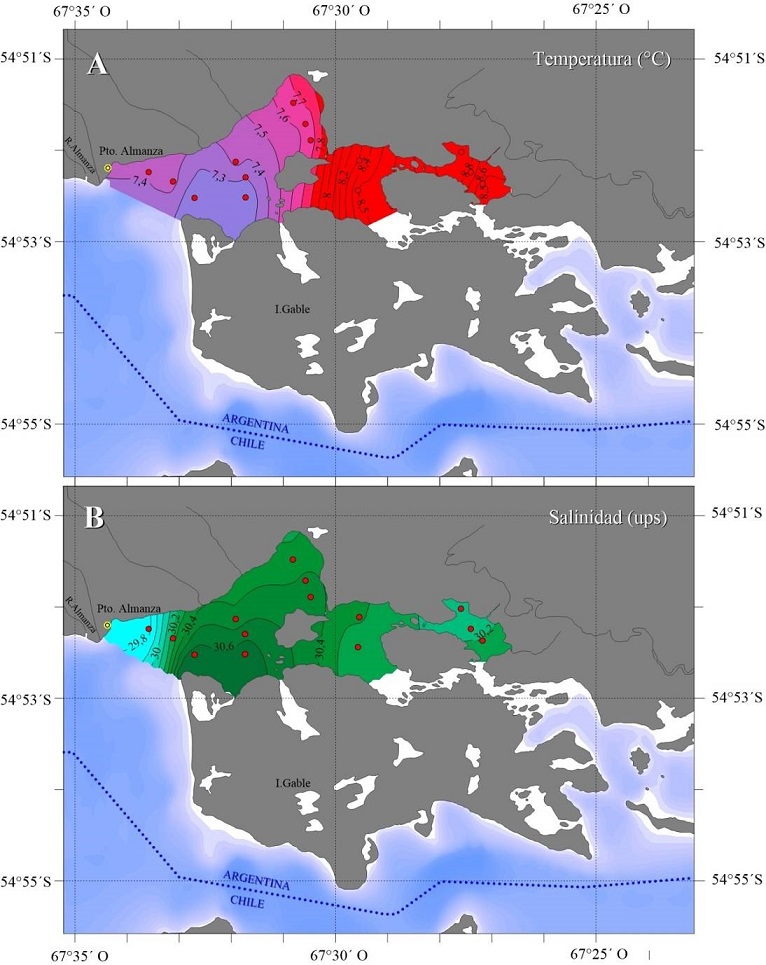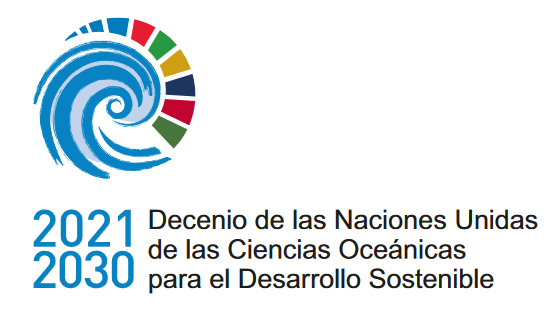Características ambientales y algas nocivas en un área de producción de moluscos bivalvos del Canal Beagle, Argentina
DOI:
https://doi.org/10.47193/mafis.3222019121901Palabras clave:
Canal Beagle, características ambientales, microalgas nocivas, perfil de toxinasResumen
En diciembre de 2013 se realizó un estudio para conocer las especies de microalgas tóxicas presentes en el área, las distintas toxinas que producen y los factores ambientales que condicionan la distribución de las comunidades de fitoplancton y su estructura. Se observó una alteración en la estructura de la comunidad fitoplantónica respecto al mismo período de años anteriores que indicó un retraso en las primeras etapas de la sucesión clásica. Dicho retraso influyó en el patrón anual de formación de floraciones de especies tóxicas en el canal y, en consecuencia, en los niveles de toxicidad de los bivalvos que normalmente se registran en esa época. El análisis de HPLC mostró escaso número de toxinas paralizantes de moluscos que coincidió con una muy baja concentración de células tóxicas. En las muestras analizadas se detectaron principalmente gonyautoxinas, sin presencia de toxina amnésica de moluscos. Los resultados aportan un conocimiento más detallado del perfil tóxico de los bivalvos de interés comercial en el área, que complementa el programa de monitoreo en curso. El análisis de los parámetros ambientales mostró que el sector interior de Bahía A. Brown es un área con circulación restringida que puede funcionar como reservorio potencial de los estadios bentónicos de resistencia de algunos dinoflagelados, proveyendo un inóculo inicial para la formación de floraciones o de eventos de toxicidad locales. La ausencia de floraciones de especies tóxicas y el bajo nivel de toxicidad de los moluscos del área en ese período se asociaron con las inusuales condiciones climáticas que se registraron en la región durante los meses previos, lo cual advierte sobre la necesidad de contar con un registro continuo de las variables meteorológicas para tratar de predecir la ocurrencia de floraciones de algas nocivas en el canal.
Descargas
Métricas
Citas
Almandoz GO, Fabro E, Ferrario M, Tillmann U, Cembella A, Krock B. 2017. Species occurrence of the potentially toxigenic diatom genus Pseudo-nitzschia and the associated neurotoxin domoic acid in the Argentine Sea. Harmful Algae. 63: 45-55.
Almandoz GO, Hernando MP, Ferreyra GA, Schloss IR, Ferrario ME. 2011. Seasonal phytoplankton dynamics in extreme southern South America (Beagle Channel, Argentina). J Sea Res. 66 (2): 47-57.
Almandoz GO, Montoya N, Hernando MP, Benavides H, Carignan M, Ferrario ME. 2014. Toxic strains of the Alexandrium ostenfeldii complex in South America (Beagle Channel, Argentina). Harmful Algae. 37: 100-109.
Álvarez M. 2012. Situación actual de las zonas de producción de moluscos bivalvos en referencia a los fenómenos de Marea Roja. Años 2008 al 2011. 5to Taller de Trabajo de la Red de Fortalecimiento para la Maricultura Costera Patagónica y del Taller de Cultivo de Mejillón. <http://www.cenpat-conicet.gov.ar/mariculturaenred/PresentacionesTaller/Mareasrojas-FerinoAlvarez.pdf>.
Amin OA. 1999. Estudio de las características oceanográficas de la Bahía Almirante Brown. Informe para la Subsecretaría de Recursos naturales y Ambiente Humano de la prov. de Tierra del Fuego, Antártida e Islas del Atlántico Sur, Argentina. 9 p.
Anderson DM. 1984. The roles of dormant cysts in toxic dinoflagellate blooms and shellfish toxicity. En: Ragelis E, editor. Seafood toxins. American Chemical Society Symposium series. Washington: American Chemical Society. p. 125-138.
Anderson DM, Wall D. 1978. Potential importance of benthic cysts of Gonyaulax tamarensis and G. excavata in initiating toxic dinoflagellate blooms. J Phycol. 14: 224-234.
Angles S, Garces E, Jordi A, Basterretxea G, Palanques A. 2010. Alexandrium minutum resting cyst distribution dynamics in a confined site. Deep-Sea Res (II Top Stud Oceanogr). 57 (3-4): 210-221.
[AOAC] Association of Official Analytical Chemists. 1985. Paralytic shellfish poison. Biological method. Final action. Official Methods of Analysis. Sec. 959.08. p. 21-22.
Avaria, S. 2008. Phytoplankton in the austral Chilean channels and fjords. Progress in the oceanographic knowledge of Chilean interior waters, from Puerto Montt to Cape Horn. En: Silva N, Palma S, editores. Valparaíso: Comité Oceanográfico Nacional-Pontificia Universidad Católica de Valparaíso. p. 89-92.
Avaria S, Caceres C, Castillo P, Muñoz P. 2003. Distribución del microfitoplancton marino en la zona del Estrecho de Magallanes-Cabo de Hornos, Chile, en la primavera de 1998 (crucero CIMAR 3 fiordos). Cienc Tecnol Mar. 26: 79-96.
Balestrini C, Manzella G, Lovrich G. 1998. Simulación de corrientes en el Canal Beagle y Bahía Ushuaia mediante un modelo bidimensional. Servicio de Hidrografía Naval, República Argentina. Departamento Oceanografía. Informe Técnico N° 98, 58 p.
Benavides H, Prado L, Diaz S, Carreto JI. 1995. An exceptional bloom of Alexandrium catenella in the Beagle Channel, Argentina. En: Lassus P, Arzul G, Erard E, Gentien P, Marcaillou C, editores. Harmful marine algal blooms. Proceedings of the Sixth International Conference on Toxic Marine Phytoplankton, October 1993, Nantes, France. p. 113-119.
Bertolotti MI, Pagani A, Gualdoni P, Fosati J. 2014. Cadena de producción del cultivo del mejillón en el año 2011 en la provincia de Tierra del Fuego, Antártida e Islas del Atlántico Sur, Argentina. Rev Galega Econo. 23: 33-50.
Bricelj VM, Shumway SE. 1998. Paralytic shellfish toxins in bivalve molluscs: occurrence transfer kinetics and biotransformation. Rev Fish Sci. 6 (4): 315-383.
Carreto JI, Carignan MO, Montoya NG. 2001. Comparative studies on mycosporine-like amino acids, paralytic shellfishtoxins and pigment profiles of the toxic dinoflagellates Alexandrium tamarense, A. catenella and A. minutum. Mar Ecol Prog Ser. 223: 49-60.
Carreto JI, Carignan MO, Montoya NG. 2002. Short term effects of ultraviolet radiation on the toxic dinoflagellate Alexandrium catenella. Pigment bleaching and MAAs synthesis inhibition. In: Aquaculture, Environment and Marine Phytoplankton. G. Arzul Coord. Ed. IFREMER, Actes colloq. 34: 173-190.
Carreto JI, Carignan MO, Montoya NG. 2005. A high-resolution reverse-phase liquid chromatography method for the analysis of mycosporine-like amino acids (MAAs) in marine organisms. Mar. Biol. 146: 237-252.
Cembella AD, Lewis NI, Quilliam MA. 2000. The marine dinoflagellate Alexandrium ostenfeldii (Dinophyceae) as the causative organism of spirolide shellfish toxins. Phycologia. 39: 67-74.
Clément A, Lincoqueo L, Saldivia M, Brito CG, Muñoz F, Fernández C, Pérez F, Maluje CP, Correa N, Moncada V, Contreras G. 2016. Exceptional summer conditions and HABs of Pseudochatonella in Southern Chile create record impacts on salmon farms. Harmful Algae News. 53: 1-3.
Costa PR, Baugh KA, Wright B, Ralonde R, Nance SL, Tatarenkova N, Etheridge SM, Lefebvre KA. 2009. Comparative determination of paralytic shellfish toxins (PSTs) using five different toxin detection methods in shellfish species collected in the Aleutian Islands, Alaska. Toxicon. 54: 313-320.
Dale B. 1976. Cyst formation, sedimentation, and preservation: factors affecting dinoflagellate assemblages in recent sediments from Trondheimsfjord, Norway. Rev Palaeobot Palynol. 22: 39-60.
[EFSA] European Food Safety Authority. 2009. Scientific opinion of the panel on contaminants in the food chain on is quest from the European Commission on marine biotoxins in shellfish-summary on regulated marine biotoxins. EFSAJ. 1306: 1-23.
Etheridge SM. 2010. Paralytic shellfish poisoning: Sea food safety and human health perspectives Toxicon. 56: 108-122.
Faust MA. 1991. Morphology of ciguatera-causing Prorocentrum lima (Pyrrophyta) from widely differing sites. J Phycol. 27: 642-648.
Ferrario ME, Sar EA, Sala S. 1995. Metodología básica para el estudio del fitoplancton con especial referencia a las diatomeas. En: Alveal K, Ferrario ME, Oliveira EC, Sar EA, editores. Manual de métodos ficológicos. Concepción: Universidad de Concepción. p. 1-23.
Fritz L, Triemer RE. 1985. A rapid simple technique utilizing Calcofluor White M28 for the visualization of dinoflagellate thecal plates. J Phycol. 21: 662-664.
Goya AB, Maldonado S. 2014. Evolution of PSP toxicity in shellfish from the Beagle Channel (Tierra del Fuego, Argentina): an overview. En: Sauvé G, editor. Molluscan shellfish safety. Dordrecht: Springer. p. 15-23.
Grasshoff K, Ehrhardt M, Kremling K. 1983. Methods of sea water analysis. Weimnheim: Verlag Chemie. 419 p.
Guzman L, Campodónico E. 1975. Marea Roja en la Región de Magallanes. Publicaciones Instituto de la Patagonia. Serie Monografías, Punta Arenas, Chile, 9. 44 p.
Guzman L, Lembeye G. 1975. Estudios sobre un florecimiento tóxico causado por Gonyaulax catenella en Magallanes. II— Algunas condiciones hidrográficas asociadas. ANS. INST. PAT., Punta Arenas (Chile). VI (1-2): 185-195.
Guzman L, Pacheco H, Pizarro G, Alarcón C. 2002. Alexandrium catenella y veneno paralizante de los mariscos en Chile. En: Sar EA, Ferrario ME, Reguera B, editores. Floraciones algales nocivas en el cono sur americano. Vigo: Instituto Español de Oceanografía. p. 235-255.
Isla F, Bujalesky G, Coronato A. 1999. Procesos estuarinos en el Canal Beagle, Tierra del Fuego. Rev Asoc Geol Argent. 64 (4): 307-318.
Hydes D, Aoyama M, Aminot A, Becker S, Coverly S, Daniel A, Dickson A, Grosso O, Kerouel R, Van Ooijen J, et al. 2010. Determination of dissolved nutrients in seawater. En: Hood EM, Sabine CL, Sloyan BM, editores. The GO-SHIP repeat hydrography manual: a collection of expert reports and guidelines. IOCCP Report No. 14, ICPO Publication Series No. 134. http://www.go-ship.org/HydroMan.html.
Jeffrey SW, Wright SW. 1997. Qualitative and quantitative HPLC analysis of SCOR reference algal cultures. En: Jeffrey SW, Mantoura RFC, Wright SW, editores. Phytoplankton pigments in oceanography: guidelines to modern methods, Vol. 10. Paris: UNESCO Monographs on Oceanographic Methodology. p. 343-360.
Kremp A, Lindholm T, Dressler N, Erler K, Gerdts G, Eirtovaara S, Leskinen E. 2009. Bloom forming Alexandrium ostenfeldii (Dinophyceae) in shallow waters of the Åland Archipelago, Northern Baltic Sea. Harmful Algae. 8: 318-328.
Krock B, Borel M, Barrera F, Tillmann U, Fabrod E, Almandoz GO, Ferrario M, Garzón Cardona JE, Kocha BP, Alonso C, et al. 2015. Analysis of the hydrographic conditions and cyst beds in the San Jorge Gulf, Argentina, that favor dinoflagellate population development including toxigenic species and their toxins. J Mar Syst. 148: 86-100.
Lassus P, Proniewski F, Maggi P, Truquet P, Bardouil M. 1993. Wind-induced toxic blooms of Dinophysis cf. acuminata in the Antifer area (France). En: Smayda TJ, Shimizu Y, editores. Toxic phytoplancton blooms in the sea. Elsevier Science Publishers. p. 519-523.
Lelong A, Garet H, Soudant P, Bates S. 2012. Pseudo-nitzschia (Bacillariophyceae) species, domoic acid and amnesic shellfish poisoning: revisiting previous paradigms. Phycologia. 51 (2): 168-216.
Lembeye G. 1998. Seguimiento de la toxicidad en recursos pesqueros de importancia comercial en la X y XI Región, Informe Final Proyecto FIP. 86 p.
Margalef R. 1978. Life forms of phytoplankton as survival alternatives in an unstable environment. Ocenol Acta. 1: 493-509.
Montoya N, Carignan M, Benavides H. 2012. Toxinas emergentes: spirolidos en mejillones, fitoplancton y en cultivo de Alexandrium ostenfeldii del Canal de Beagle. Inf Invest INIDEP N° 116/2012.
Montoya NG, Fulco KV, Carignan MO, Carreto JI. 2010. Toxin variability in cultured and natural populations of Alexandrium tamarense from southern South America – Evidences of diversity and environmental regulation. Toxicon. 56: 1408-1418.
Muñoz JL, Urbina MA, Garreaud R, Iriarte JL. 2018. Hydroclimatic conditions trigger record harmful algal bloom in western Patagonia (Summer 2016). Scientific Reports (2018) 8:1330. DOI: https://doi.org/10.1038/s41598-018-19461-4
Nagai S, Nitshitani G, Tomaru Y, Sakiyama S, Kamiyama T. 2008. Predation by the toxic dinoflagellate Dinophysis fortii on the ciliate Myrionecta rubra and observation of sequestration of ciliate chloroplasts. J Phycol. 44 (4): 909-922.
Oshima Y. 1995. Post-column derivatisation liquid chromatography method for paralytic shellfish toxins. J AOAC Int. 78: 528-532.
Peperzak L, Snoeijer GJ, Dijkema R, Gieskes WWC, Joordens J, Peeters JCH, Vrieling EG, Zevenboom W. 1996. Development of Dinophysis acuminata bloom in the river Rhine plume. En: Yasumoto T, Oshima Y, Fukuyo Y, editores. Harmful and toxic algal blooms. Intergovernmental Oceanographic Commission of UNESCO. 273-276.
Pizarro G, Iriarte, JL, Montecino V, Blanco JL, Guzmán L. 2000. Distribución de la biomasa fitoplanctónica y productividad primaria máxima de fiordos y canales australes (47°-50° S) en octubre 1996. Cienc Tecnol Mar. 23: 25-48.
Pizarro G, Montecino V, Guzman L, Muñoz V, Chacon V, Pacheco H, Frangopulos M, Retamal L, Alarcon C. 2005. Patrones anuales recurrentes del fitoplancton en fiordos y canales australes (43°-53° S) en primavera y verano. Cienc Tecnol Mar. 28 (2): 63-83.
Quiros R, Luchini L, Wicki G, Errazti E. 1993. Evaluación e identificación de sitios aptos para el desarrollo de la acuicultura. Sobre la zona costera de la Isla Grande de tierra del Fuego y sus aguas interiores. Informe final para la Dirección de Recursos Naturales de la Prov. de Tierra del fuego Antártida e Islas del Atlántico sur. Consejo Federal de Inversiones de la República Argentina. Vol. I, II y II, 385 p.
Reid PC. 1997. Discharges from hydroelectric power schemes as a trigger for marine algal blooms. Mar Pollut Bull. 34 (9): 730-733.
[SAGPYA] Secretaría de Agricultura, Pesca y Alimentación. 2006. Capitulo XXIII Productos de la Pesca 23.24 Reglamento Sanitario de explotación y comercialización de moluscos y bivalvos vivos para consumo humano directo. Resolución SAGPYA 829/2006. Decreto 4238/68.
[SMN] Servicio Meteorológico Nacional. 2013. Boletín climatológico trimestral. Primavera. Vol. XXV 2013. 13 p. http://www3.smn.gob.ar/serviciosclimaticos/clima/archivo/clim-primav13.pdf.
Simonsen R. 1974. The diatom plankton of the Indian Ocean Expedition of R.V. “Meteor” 1964-65. Meteor Forschungsergeb (D Biol). 19: 1-66.
Smayda, T.J. 2002. Turbulence, watermass stratification and harmful algal blooms: an alternative view and frontal zones as “pelagic seed banks”. Harmful Algae. 1: 95-112.
Smayda TJ, Reynolds CS. 2001. Community assembly in marine phytoplankton: application of recent models to harmful dinoflagellate blooms J Plank Res. 23 (5): 447-461.
Touzet N, Franco JM, Raine R. 2008. Morphogenetic diversity and biotoxin composition of Alexandrium (Dinophyceae) in Irish coastal waters. Harmful Algae. 7: 782-797.
Utermöhl H. 1958. Zur vervollkommung der quantitative phytoplankton-methodik. Mitt Int Ver Theor Angew Limnol. 9: 1-38.
Vera P, Avaria S, Muñoz P. 1996. Composición y distribución del fitoplancton de los fiordos adyacentes a Campos de Hielo Sur, Chile. Cienc Tecnol Mar. 19: 73-92.
Wright JLC, Quilliam MA, Cembella AD. 1995. Methods for domoic acid, the Amnesic Shellfish Poisons. En: Hallegraeff GM, Anderson DM, Cembella AD, editores. Manual on Harmful Marine Microalgae, COI, Manual Guides N° 33, UNESCO, Paris, p 113-133.
Zapata M, Rodriguez F, Garrido JL. 2000. Separation of chlorophylls and carotenoids from marine phytoplankton: a new HPLC method using a reversed phase C8 column and pyridine-containing mobile phases. Mar Ecol Prog Ser. 195: 29-45.

Publicado
Cómo citar
Número
Sección
Licencia
Derechos de autor 2020 Hugo Benavides, Nora G. Montoya, Mario Carignan, Carlos Luizón

Esta obra está bajo una licencia internacional Creative Commons Atribución-NoComercial-CompartirIgual 4.0.
Los autores de los artículos publicados en Marine and Fishery Sciences conservan los derechos de autor de sus artículos, a excepción de las imágenes de terceros y otros materiales añadidos por Marine and Fishery Sciences, que están sujetos a los derechos de autor de sus respectivos propietarios. Por lo tanto, los autores son libres de difundir y volver a publicar sus artículos, sujeto a los requisitos de los propietarios de derechos de autor de terceros y sujeto a que la publicación original sea completamente citada. Los visitantes también pueden descargar y reenviar artículos sujetos a los requisitos de citas. La capacidad de copiar, descargar, reenviar o distribuir cualquier material siempre está sujeta a los avisos de derechos de autor que se muestran. Los avisos de copyright deben mostrarse de manera prominente y no pueden borrarse, eliminarse u ocultarse, total o parcialmente. El autoalmacenamiento en servidores y repositorios de preimpresión está permitido para todas las versiones.
Esta revista ofrece a los autores una política de acceso abierto. Los usuarios pueden leer, descargar, copiar, distribuir, imprimir, buscar o vincular los textos completos de los artículos, o usarlos para cualquier otro propósito legal dentro de la licencia Creative Commons 4.0 (BY-NC-SA), sin solicitar permiso previo del editor o del autor. Esto está de acuerdo con la definición BOAI de acceso abierto.



























